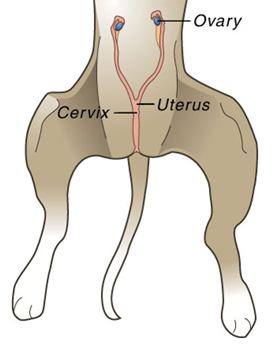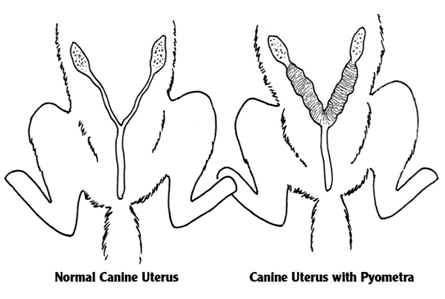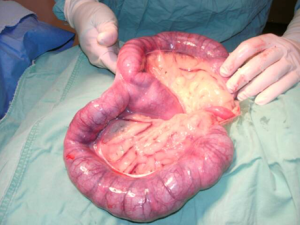 What is a Pyometra?
What is a Pyometra?
“Pyometra” is an infection of the uterus of unspayed cats or dogs after a heat cycle. This condition can happen at any age but is more commonly seen in older pets and can be deadly if left untreated.
After several heat cycles, the uterus changes! The uterus becomes very thick and has excess tissue that would be used to support a potential pregnancy. Without a pregnancy to support, the uterine lining grows in thickness and cysts can form in the tissues, resulting in condition known as “Cystic Endometrial Hyperplasia.” This cyst-covered lining secretes a fluid into the uterus, creating an ideal environment for bacteria to grow in. High levels of progesterone (a hormone involved in heat cycles) do not allow the uterus to contract so as to expel fluid, leading to an accumulation of bacteria inside the uterus. While the bacteria inside the vagina is healthy, if it crosses into the cervix it can cause the infection which leads to a pyometra. Not all dogs who develop a pyometra will contract “Cystic Endometrial Hyperplasia.”
 Bacteria enters into the uterus by way of the cervix. The cervix is normally tightly closed, except during a heat cycle where it remains open and relaxed so sperm can enter freely into the uterus. A healthy vagina contains bacteria which can cross over into the cervix during a heat cycle and develop into a pyometra.
Bacteria enters into the uterus by way of the cervix. The cervix is normally tightly closed, except during a heat cycle where it remains open and relaxed so sperm can enter freely into the uterus. A healthy vagina contains bacteria which can cross over into the cervix during a heat cycle and develop into a pyometra.
What are the possible signs of a Pyometra?
The signs can be different depending on whether the cervix is open or closed. In an open-cervix pyometra, the pus and/or discharge can drain out through the vagina. A pet may also have a fever, become very tired or lethargic and may not want to eat or drink.
In a closed-cervix pyometra, the uterus continues to swell with accumulation of pus and fluid, resulting in the abdomen becoming distended. The bacteria within the uterus can release toxins into the bloodstream, affecting the rest of the body very quickly. These pets seem to fall ill very quickly – they are incredibly lethargic and depressed, refusing water or food and may vomit or have diarrhea.

How is a pyometra diagnosed?
Dogs seen by a veterinarian early on in the condition may not show all of the above signs. They may just have slight vaginal discharge with not many other signs of illness. Because of the seemingly quick onset of a pyometra, most dogs are not seen until later on in the condition.
If a pyometra is suspected, a veterinarian will perform radiographs to see if the uterine is enlarged. However, if it is a closed-cervix pyometra, radiographs may not show an enlarged uterus. An ultrasound can also be performed to differentiate a pyometra from a normal pregnancy. A veterinarian will also perform bloodwork to see how the organs are functioning within the body. An elevated white blood cell count (a tell-tale sign of infection) and elevation of globulins (a protein associated with the immune system) may be present in a dog with a pyometra.
What is the best way to treat a Pyometra?
 A pyometra can be life-threatening if not treated immediately. The preferred treatment is surgical removal of the entire uterus, otherwise known as an ovariohysterectomy or “spay”. The spay procedure is very routine, however when a pet develops a pyometra, the procedure becomes more complicated and risky as the patient going under sedation is sick. The surgeon will remove the infected uterus and ovaries and take precaution as to not accidentally puncture the swollen organs. Pets who are diagnosed early on in this condition are an excellent candidate for surgery. Pets that are further along in the infection will require a longer period of hospitalization while running on intravenous fluids to stabilize the pet before and after undergoing surgery. Antibiotics may be added to treatment as well.
A pyometra can be life-threatening if not treated immediately. The preferred treatment is surgical removal of the entire uterus, otherwise known as an ovariohysterectomy or “spay”. The spay procedure is very routine, however when a pet develops a pyometra, the procedure becomes more complicated and risky as the patient going under sedation is sick. The surgeon will remove the infected uterus and ovaries and take precaution as to not accidentally puncture the swollen organs. Pets who are diagnosed early on in this condition are an excellent candidate for surgery. Pets that are further along in the infection will require a longer period of hospitalization while running on intravenous fluids to stabilize the pet before and after undergoing surgery. Antibiotics may be added to treatment as well.
The chance of survival without surgery is very low. If treatment is not started promptly, toxins from the infection can spill into the bloodstream, affecting the rest of the body system. In a closed-cervix pyometra, there is an additional risk where the uterus could potentially burst, causing pus and bacteria to spill over into the abdomen.
What is the best way to prevent a pyometra?
Spaying your pet is the best way to prevent a pyometra. Spaying your pets also reduces their risk of developing mammary cancers and completely eliminates unwanted pregnancies. If you have decided to breed your pet and do not want more litters, you should promptly spay your pet. As the amount of heat cycles increase without development of pregnancy, the greater the chance of uterine infection.
Sources:
https://www.texvetpets.org/article/pyometra-in-unspayed-pets/
https://vcahospitals.com/know-your-pet/pyometra-in-dogs
http://veterinarymedicine.dvm360.com/canine-pyometra-early-recognition-and-diagnosis?id=&pageID=1&sk=&date
By: Madison Cole